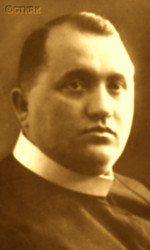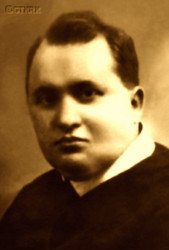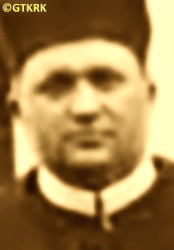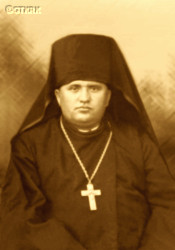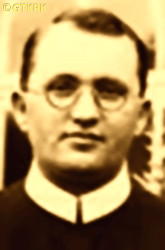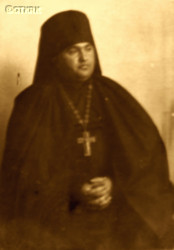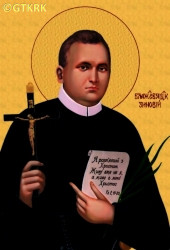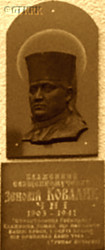Roman Catholic
St Sigismund parish
05-507 Słomczyn
85 Wiślana Str.
Konstancin deanery
Warsaw archdiocese, Poland
full list:
displayClick to display full list

searchClick to search full list by categories
wyświetlKliknij by wyświetlić pełną listę po polsku

szukajKliknij by przeszukać listę wg kategorii po polsku

Martyrology of the clergy — Poland
XX century (1914 – 1989)
personal data
religious status
blessed
surname
KOWALIK
forename(s)
Zeno (pl. Zenon)
forename(s)
versions/aliases
Zenobius (pl. Zenobiusz)
beatification date
27.06.2001more on
www.swzygmunt.knc.pl
[access: 2013.05.19]

the RC Pope John Paul IImore on
en.wikipedia.org
[access: 2014.09.21]
function
religious cleric
creed
Ukrainian Greek Catholic GCmore on
en.wikipedia.org
[access: 2013.05.19]
congregation
Congregation of the Most Holy Redeemer CSsRmore on
en.wikipedia.org
[access: 2013.05.19]
(i.e. Redemptorists)
diocese / province
Lviv Greek Catholic Vice‐Province CSsR
nationality
Ukrainian
date and place
of death
28.06.1941

Lvivtoday: Lviv urban hrom., Lviv rai., Lviv obl., Ukraine
more on
en.wikipedia.org
[access: 2022.01.16]
details of death
In 1935 forced by Polish authorities to leave Volyn and stop missionary activities among Orthodox Christians.
After German and Russian invasion of Poland in 09.1939 and start of the World War II, after start of Russian occupation, arrested by the Russians on 20.12.1940.
Held in Brygidki prison in Lviv.
Accused of espionage.
Repeatedly interrogated and tortured.
Murdered after German attack on 22.06.1941 of their erstwhile ally, Russians, murdered prob. in Zamarstynów prison — Russians prior to their escape were to nail him to the prison cell wall and put an unborn child into his cut open belly.
cause of death
mass murder
perpetrators
Russians
sites and events
06.1941 massacres (NKVD)Click to display the description, Lviv (Zamarstiniv)Click to display the description, Lviv (Brygidki)Click to display the description, Ribbentrop‐MolotovClick to display the description, Pius XI's encyclicalsClick to display the description
date and place
of birth
18.08.1903

Ivachiv Horishnytoday: Bila hrom., Ternopil rai., Ternopil obl., Ukraine
more on
uk.wikipedia.org
[access: 2023.03.02]
parents
KOWALIK Gregory
🞲 ?, ? — 🕆 ?, ?

Michelle
🞲 ?, ? — 🕆 ?, ?
religious vows
28.08.1926 (temporary)
28.08.1929 (permanent)
presbyter (holy orders)
ordination
09.08.1932

positions held
1939 – 1940
friar — Lvivtoday: Lviv urban hrom., Lviv rai., Lviv obl., Ukraine
more on
en.wikipedia.org
[access: 2022.01.16] ⋄ GC Congregation's house (at Zybilkiewicza Str.), Redemptorists CSsR — people's missionary and administrator of Congregation's local elementery schools
1935 – 1939
friar — Stanislavivtoday: Ivano‐Frankivsk, Stanislaviv/Ivano‐Frankivsk rai., Stanislaviv/Ivano‐Frankivsk obl., Ukraine
more on
en.wikipedia.org
[access: 2020.11.20] ⋄ Blessed Virgin Mary of Perpetual Help GC Congregation's house, Redemptorists CSsR — people's missionary and administrator of Congregation's local elementery schools
1932 – 1935
friar — Koveltoday: Kovel urban hrom., Kovel rai., Volyn obl., Ukraine
more on
en.wikipedia.org
[access: 2021.12.19] ⋄ Congregation's house, Redemptorists CSsR — people's missionary in Volyn
1933
friar — LvivHolosko district
today: Lviv urban hrom., Lviv rai., Lviv obl., Ukraine
more on
en.wikipedia.org
[access: 2022.11.29] ⋄ GC Congregation's house („Holosko”), Redemptorists CSsR — second novitiate, i.e. missionary preparation
02.09.1926 – 1932
student — Louvaintoday: Flemish Brabant prov., Flemish reg., Belgium
more on
en.wikipedia.org
[access: 2020.11.07] ⋄ Higher Theologica Seminary, i.e. Studentate, Redemptorists CSsR — it is possible that studied at the St John the Evangelist monastery in Beauplateau (Walloon Reg., Luxembourg Prov., Sainte–Ode Com.)
27.08.1925 – 28.08.1926
novitiate — LvivHolosko district
today: Lviv urban hrom., Lviv rai., Lviv obl., Ukraine
more on
en.wikipedia.org
[access: 2022.11.29] ⋄ GC Congregation's house („Holosko”), Redemptorists CSsR
03.07.1925
accession — Redemptorists CSsR
till c. 1925
teacher — Ternopiltoday: Ternopil urban hrom., Ternopil rai., Ternopil obl., Ukraine
more on
en.wikipedia.org
[access: 2020.11.20] ⋄ elementary school — in the town or its vicinity
others related
in death
BAŁUTClick to display biography Anthony (Fr Roman), BANSZELClick to display biography Charles, BUCZYŃSKIClick to display biography Joseph, CZEMERYŃSKIClick to display biography Yaroslav Anthony, KAŹNICAClick to display biography Monica, KNYSZClick to display biography Stephen, KONOPKAClick to display biography Casimir Stanislav, MARCHIEWICZClick to display biography Francis (Fr Michael), PISKOZUBClick to display biography Julia, OSIDACZClick to display biography Roman, ZAWOROTIUKClick to display biography Michael, KOWERKOClick to display biography Maximilian, STOKŁOSAClick to display biography Joseph
sites and events
descriptions
06.1941 massacres (NKVD): After German attack of Russian‐occupied Polish territory and following that of Russia itself, before a panic escape, Russians murdered — in accordance with the genocidal order issued on 24.06.1941 by the Russian interior minister Lawrence Beria to murder all prisoners (formally „sentenced” for „counter‐revolutionary activities”, „anti‐Russian acts”, sabotage and diversion, and political prisoners „in custody”), held in NKVD‐run prisons in Russian occupied Poland, Lithuania, Latvia and Estonia — c. 40,000‐50,000 prisoners. In addition Russians murdered many thousands of victims arrested after German attack regarding them as „enemies of people” — those victims were not even entered into prisons’ registers. Most of them were murdered in massacres in the prisons themselves, the others during so‐called „death marches” when the prisoners were driven out east. After Russians departure and start of German occupation a number of spontaneous pogroms of Jews took place. Many Jews collaborated with Russians and were regarded as co‐responsible for prison massacres. (more on: en.wikipedia.orgClick to attempt to display webpage
[access: 2021.12.19])
Lviv (Zamarstiniv): Penal prison no 2 in Lviv. In 1939‐1941 Russians organised there an NKVD detention centre and jailed thousands of prisoners, mainly Poles and Ukrainians, interrogating them and torturing. In 06.1941 after German invasion Russians murdered few thousands of them in a mass massacre. (more on: pl.wikipedia.orgClick to attempt to display webpage
[access: 2015.09.30])
Lviv (Brygidki): Penal prison, then at 34 Kazimierzowska Str. in Lviv — in the buildings of the former monastery of the Order of St Brigid, in 1784 — after the first partition of Poland and after the dissolution of the religious orders as part of the so—called Josephine dissolutions — converted by the partitioning Austrian authorities into a prison. In 1939‐1941, the Russians held there thousands of prisoners, most of them Poles. On c. 26.06.1941, in the face of the German invasion and attack of their erstwhile ally, the Russians, during a panic escape (the left Lviv exactly on 26.06.1941), genocideally murdered several thousand prisoners. In 1941‐1944 the prison was run by the Germans and mass murders of Polish, Jewish and Ukrainian civilians took place there. After start of another Russian occupation in 1941 prison in which the executions were carried out on prisoners sentenced to death. (more on: en.wikipedia.orgClick to attempt to display webpage
[access: 2014.09.21])
Ribbentrop‐Molotov: Genocidal Russian‐German alliance pact between Russian leader Joseph Stalin and German leader Adolf Hitler signed on 23.08.1939 in Moscow by respective foreign ministers, Mr. Vyacheslav Molotov for Russia and Joachim von Ribbentrop for Germany. The pact sanctioned and was the direct cause of joint Russian and German invasion of Poland and the outbreak of the World War II in 09.1939. In a political sense, the pact was an attempt to restore the status quo ante before 1914, with one exception, namely the „commercial” exchange of the so‐called „Kingdom of Poland”, which in 1914 was part of the Russian Empire, fore Eastern Galicia (today's western Ukraine), in 1914 belonging to the Austro‐Hungarian Empire. Galicia, including Lviv, was to be taken over by the Russians, the „Kingdom of Poland” — under the name of the General Governorate — Germany. The resultant „war was one of the greatest calamities and dramas of humanity in history, for two atheistic and anti‐Christian ideologies — national and international socialism — rejected God and His fifth Decalogue commandment: Thou shall not kill!” (Abp Stanislav Gądecki, 01.09.2019). The decisions taken — backed up by the betrayal of the formal allies of Poland, France and Germany, which on 12.09.1939, at a joint conference in Abbeville, decided not to provide aid to attacked Poland and not to take military action against Germany (a clear breach of treaty obligations with Poland) — were on 28.09.1939 slightly altered and made more precise when a treaty on „German‐Russian boundaries and friendship” was agreed by the same murderous signatories. One of its findings was establishment of spheres of influence in Central and Eastern Europe and in consequence IV partition of Poland. In one of its secret annexes agreed, that: „the Signatories will not tolerate on its respective territories any Polish propaganda that affects the territory of the other Side. On their respective territories they will suppress all such propaganda and inform each other of the measures taken to accomplish it”. The agreements resulted in a series of meeting between two genocidal organization representing both sides — German Gestapo and Russian NKVD when coordination of efforts to exterminate Polish intelligentsia and Polish leading classes (in Germany called «Intelligenzaktion», in Russia took the form of Katyń massacres) where discussed. Resulted in deaths of hundreds of thousands of Polish intelligentsia, including thousands of priests presented here, and tens of millions of ordinary people,. The results of this Russian‐German pact lasted till 1989 and are still in evidence even today. (more on: en.wikipedia.orgClick to attempt to display webpage
[access: 2015.09.30])
Pius XI's encyclicals: Facing the creation of two totalitarian systems in Europe, which seemed to compete with each other, though there were more similarities than contradictions between them, Pope Pius XI issued in 03.1937 (within 5 days) two encyclicals. In the „Mit brennender Sorge” (Eng. „With Burning Concern”) published on 14.03.1938, condemned the national socialism prevailing in Germany. The Pope wrote: „Whoever, following the old Germanic‐pre‐Christian beliefs, puts various impersonal fate in the place of a personal God, denies the wisdom of God and Providence […], whoever exalts earthly values: race or nation, or state, or state system, representatives of state power or other fundamental values of human society, […] and makes them the highest standard of all values, including religious ones, and idolizes them, this one […] is far from true faith in God and from a worldview corresponding to such faith”. On 19.03.1937, published „Divini Redemptoris” (Eng. „Divine Redeemer”), in which criticized Russian communism, dialectical materialism and the class struggle theory. The Pope wrote: „Communism deprives man of freedom, and therefore the spiritual basis of all life norms. It deprives the human person of all his dignity and any moral support with which he could resist the onslaught of blind passions […] This is the new gospel that Bolshevik and godless communism preaches as a message of salvation and redemption of humanity”… Pius XI demanded that the established human law be subjected to the natural law of God , recommended the implementation of the ideal of a Christian state and society, and called on Catholics to resist. Two years later, National Socialist Germany and Communist Russia came together and started World War II. (more on: www.vatican.vaClick to attempt to display webpage
[access: 2023.05.28], www.vatican.vaClick to attempt to display webpage
[access: 2023.05.28])
sources
personal:
old.cssr.lviv.uaClick to attempt to display webpage
[access: 2019.12.26], pl.wikipedia.orgClick to attempt to display webpage
[access: 2013.05.19]
original images:
www.cssr.lviv.uaClick to attempt to display webpage
[access: 2015.09.30], www.redemptorist.ruClick to attempt to display webpage
[access: 2015.09.30], photo-lviv.in.uaClick to attempt to display webpage
[access: 2019.12.26], uk.wikipedia.orgClick to attempt to display webpage
[access: 2015.09.30], photo-lviv.in.uaClick to attempt to display webpage
[access: 2019.12.26], www.catholic.orgClick to attempt to display webpage
[access: 2015.09.30], old.cssr.lviv.uaClick to attempt to display webpage
[access: 2019.12.26], commons.wikimedia.orgClick to attempt to display webpage
[access: 2015.09.30]
LETTER to CUSTODIAN/ADMINISTRATOR
If you have an Email client on your communicator/computer — such as Mozilla Thunderbird, Windows Mail or Microsoft Outlook, described at WikipediaPatrz:
en.wikipedia.org, among others — try the link below, please:
LETTER to CUSTODIAN/ADMINISTRATORClick and try to call your own Email client
If however you do not run such a client or the above link is not active please send an email to the Custodian/Administrator using your account — in your customary email/correspondence engine — at the following address:

giving the following as the subject:
MARTYROLOGY: KOWALIK Zeno
To return to the biography press below:
 Click to return to biography
Click to return to biography








